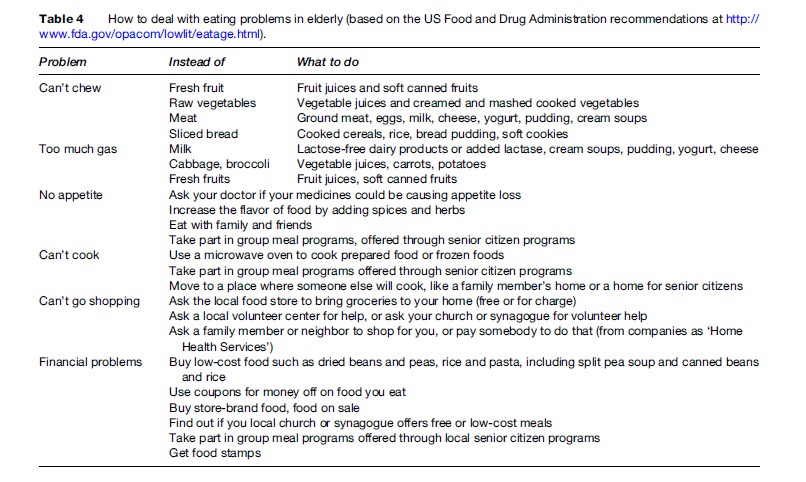See Table 4 on how to avoid eating problems in the elderly.

Perspective Of Nutrition In The Elderly
The effect of caloric restriction on delaying aging process and prolonging the lifespan, proven in rodents, has not yet been fully explored in humans (Bengmark, 2006), so other approaches may be effective. Nutrition is a promising approach to modulating the risk of aging-related diseases by the effects of certain nutrients on gene expression. One of the most practical applications of nutritional modulation of chronic disease associated with aging may be nutrients that regulate the expression of inflammatory genes (Kornman, 2006). The anti-inflammatory molecules such as polyphenols may be effective in delaying of aging-related disease (Bengmark, 2006).
Recent studies show a positive effect of dietary sources that stimulate bone morphogenetic protein (BMP) promoter, which stimulates bone formation and thus improves bone mass in the elderly with osteoporosis. Flavonoids and statins occur naturally in food products and can promote bone formation. It may be possible to influence peak bone mass by dietary means and thus decrease the risk of osteoporosis in later life (Mundy, 2006).
New therapeutic and supplementation standards for the elderly to maintain their cognitive function and to reduce the cost of dementia can be obtained from the Nutrition, Aging, and Memory in Elders (NAME) Study of micronutrients and cognitive function in elderly (Scott et al., 2006).
Nutrigenomics is associated with the issue of personalized nutrition, since claims are being made that differences in genotype should result in differences in the diet and health relationship (e.g., folate metabolism, when a common polymorphism exists for the gene that encodes methylenetetrahydrofolate reductase). Many, possibly thousands, of other gene polymorphisms might result in minor deviations in nutritional biochemistry, where only marginal or additive effects would result from these deviations.
Summary
In summary, nutritional requirements in macro and micronutrients in the elderly differ from adults because of aging-associated effects on nutrient ingestion, digestion, absorption, and metabolism. Aging-related diseases, the effects of aging on nutrients, drug–nutrient interactions, and social problems should be taken into account when analyzing the nutritional status of the older person. Future studies will help to understand how to manipulate nutrition to alter the aging process in humans.
Bibliography:
- Aoki HM, Kimoto K, Hori N, et al. (2005) Cell proliferation in the dentate gyrus of rat hippocampus is inhibited by soft diet feeding. Gerontology 51(6): 369–374.
- Bengmark S (2006) Impact of nutrition on aging and disease. Current Opinion in Clinical Nutrition and Metabolic Care 9(1): 2–7.